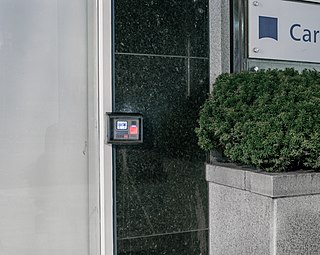Related Research Articles

In physical security and information security, access control (AC) is the selective restriction of access to a place or other resource, while access management describes the process. The act of accessing may mean consuming, entering, or using. Permission to access a resource is called authorization.
In the security engineering subspecialty of computer science, a trusted system is one that is relied upon to a specified extent to enforce a specified security policy. This is equivalent to saying that a trusted system is one whose failure would break a security policy.

Security-Enhanced Linux (SELinux) is a Linux kernel security module that provides a mechanism for supporting access control security policies, including mandatory access controls (MAC).
In computer systems security, role-based access control (RBAC) or role-based security is an approach to restricting system access to authorized users, and to implementing mandatory access control (MAC) or discretionary access control (DAC).
The Bell–LaPadula model (BLP) is a state machine model used for enforcing access control in government and military applications. It was developed by David Elliott Bell, and Leonard J. LaPadula, subsequent to strong guidance from Roger R. Schell, to formalize the U.S. Department of Defense (DoD) multilevel security (MLS) policy. The model is a formal state transition model of computer security policy that describes a set of access control rules which use security labels on objects and clearances for subjects. Security labels range from the most sensitive, down to the least sensitive.
Rule-set-based access control (RSBAC) is an open source access control framework for current Linux kernels, which has been in stable production use since January 2000.
In computer security, mandatory access control (MAC) refers to a type of access control by which a secured environment constrains the ability of a subject or initiator to access or modify on an object or target. In the case of operating systems, the subject is a process or thread, while objects are files, directories, TCP/UDP ports, shared memory segments, or IO devices. Subjects and objects each have a set of security attributes. Whenever a subject attempts to access an object, the operating system kernel examines these security attributes, examines the authorization rules in place, and decides whether to grant access. A database management system, in its access control mechanism, can also apply mandatory access control; in this case, the objects are tables, views, procedures, etc.
Multilevel security or multiple levels of security (MLS) is the application of a computer system to process information with incompatible classifications, permit access by users with different security clearances and needs-to-know, and prevent users from obtaining access to information for which they lack authorization. There are two contexts for the use of multilevel security.
Most file systems include attributes of files and directories that control the ability of users to read, change, navigate, and execute the contents of the file system. In some cases, menu options or functions may be made visible or hidden depending on a user's permission level; this kind of user interface is referred to as permission-driven.
A computer security model is a scheme for specifying and enforcing security policies. A security model may be founded upon a formal model of access rights, a model of computation, a model of distributed computing, or no particular theoretical grounding at all. A computer security model is implemented through a computer security policy.

AppArmor is a Linux kernel security module that allows the system administrator to restrict programs' capabilities with per-program profiles. Profiles can allow capabilities like network access, raw socket access, and the permission to read, write, or execute files on matching paths. AppArmor supplements the traditional Unix discretionary access control (DAC) model by providing mandatory access control (MAC). It has been partially included in the mainline Linux kernel since version 2.6.36 and its development has been supported by Canonical since 2009.
The concept of type enforcement (TE), in the field of information technology, is an access control mechanism for regulating access in computer systems. Implementing TE gives priority to mandatory access control (MAC) over discretionary access control (DAC). Access clearance is first given to a subject accessing objects based on rules defined in an attached security context. A security context in a domain is defined by a domain security policy. In the Linux security module (LSM) in SELinux, the security context is an extended attribute. Type enforcement implementation is a prerequisite for MAC, and a first step before multilevel security (MLS) or its replacement multi categories security (MCS). It is a complement of role-based access control (RBAC).
In computer security, lattice-based access control (LBAC) is a complex access control model based on the interaction between any combination of objects and subjects.
A cross-domain solution (CDS) is an integrated information assurance system composed of specialized software, and sometimes hardware, that provides a controlled interface to manually or automatically enable and/or restrict the access or transfer of information between two or more security domains based on a predetermined security policy. CDSs are designed to enforce domain separation and typically include some form of content filtering, which is used to designate information that is unauthorized for transfer between security domains or levels of classification, such as between different military divisions, intelligence agencies, or other operations which depend on the timely sharing of potentially sensitive information.

In computer security, organization-based access control (OrBAC) is an access control model first presented in 2003. The current approaches of the access control rest on the three entities to control the access the policy specifies that some subject has the permission to realize some action on some object.
Attribute-based access control (ABAC), also known as policy-based access control for IAM, defines an access control paradigm whereby a subject's authorization to perform a set of operations is determined by evaluating attributes associated with the subject, object, requested operations, and, in some cases, environment attributes.
Mandatory Integrity Control (MIC) is a core security feature of Windows Vista and later that adds mandatory access control to running processes based on their Integrity Level (IL). The IL represents the level of trustworthiness of an object. This mechanism's goal is to restrict the access permissions for potentially less trustworthy contexts, compared with other contexts running under the same user account that are more trusted.

Trusted Computer System Evaluation Criteria (TCSEC) is a United States Government Department of Defense (DoD) standard that sets basic requirements for assessing the effectiveness of computer security controls built into a computer system. The TCSEC was used to evaluate, classify, and select computer systems being considered for the processing, storage, and retrieval of sensitive or classified information.
In information security, computer science, and other fields, the principle of least privilege (PoLP), also known as the principle of minimal privilege (PoMP) or the principle of least authority (PoLA), requires that in a particular abstraction layer of a computing environment, every module must be able to access only the information and resources that are necessary for its legitimate purpose.
In computer security, general access control includes identification, authorization, authentication, access approval, and audit. A more narrow definition of access control would cover only access approval, whereby the system makes a decision to grant or reject an access request from an already authenticated subject, based on what the subject is authorized to access. Authentication and access control are often combined into a single operation, so that access is approved based on successful authentication, or based on an anonymous access token. Authentication methods and tokens include passwords, biometric scans, physical keys, electronic keys and devices, hidden paths, social barriers, and monitoring by humans and automated systems.
References
Citations
- ↑ Trusted Computer System Evaluation Criteria. United States Department of Defense. December 1985. DoD Standard 5200.28-STD. Archived from the original on 2006-05-27.
- ↑ http://fedoraproject.org/wiki/Features/RemoveSETUID – Fedora 15 set to remove SETUID in favor of (Linux kernel) capabilities
Sources
- P. A. Loscocco, S. D. Smalley, P. A. Muckelbauer, R. C. Taylor, S. J. Turner, and J. F. Farrell. The Inevitability of Failure: The Flawed Assumption of Security in Modern Computing Environments . In Proceedings of the 21st National Information Systems Security Conference, pp. 303–14, Oct. 1998. PDF version.